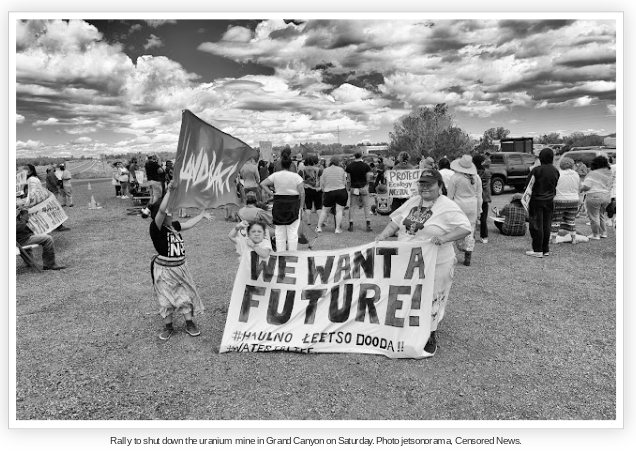From the Open-Publishing Calendar
From the Open-Publishing Newswire
Indybay Feature
Lakotas Ride in Solidarity with Havasupai 'Shut Down Uranium Mine in Grand Canyon!'
Oglala Lakota horseback riders from Pine Ridge, South Dakota, led the rally in defense of the sacred homeland of Havasupai on Saturday, continuing the demand to shut down Pinyon Plain uranium mine, threatening Havasupai's aquifer and spewing radioactive dust across the Grand Canyon.

Lakota Horseback Riders Lead the Demand to Shut Down Uranium Mine in Grand Canyon
By Brenda Norrell, Censored News, August 24, 2024
Oglala Lakota horseback riders from Pine Ridge, South Dakota, led the rally in defense of the sacred homeland of Havasupai on Saturday, continuing the demand to shut down Energy Fuels Pinyon Plain uranium mine, threatening Havasupai's aquifer and spewing radioactive dust across the Grand Canyon.
The potentially deadly haul route has already endangered Havasupai, Paiute, Dine' and Hopi on its haul route to the Energy Fuels uranium mill in the White Mesa Ute community in southeastern Utah. Radioactive trucks carried their loads across the region in secrecy. On the Navajo Nation, police were in pursuit, but the trucks reached the mill, where Ute are being poisoned by the radioactive waste.
The legacy of death from uranium mining already spreads across the Southwest. Scattered radioactive tailings are spread across the Navajo Nation from Cold War uranium mines, which the U.S. has not cleaned up. The dangerous processing mill in southeastern Utah is now bringing in radioactive waste from Europe.
Carletta Tilousi, Havasupai, speaking at the Santa Fe Indian Market in August, urged support to protect their sacred water and Red Butte from the uranium mining of Pinyon Plain mine. Sharing how she grew up in her homeland, in the bottom of the Grand Canyon, Tilousi said she has been fighting this battle since the age of 14.
"Havasu Creek is one of the oldest aquifers in the Southwest," she said, adding that it drains into her village and creates the waterfalls.
"That's the water we're trying to protect," she said, pointing out it is a small tribe, with only 597 Havasupai tribal members.
"We don't know when the contamination is going to reach us, it's just a matter of time."
Although 600 uranium mining claims have been eliminated, the Pinyon Plain uranium mine maintains its claim and is mining.
"This mine is next to our sacred mountain, Red Butte, where our Creation Stories come from. It is now being desecrated," she said, pointing out that it is unknown what is in the air from the uranium mining, and how the medicine plants there, cedar and sage, are being affected, for their sweat lodges.
"Our voice is through our art, our voice is through our songs."
Tilousi, urging unity, called for all people to stand together and protect the sacred waters.
More photos from Saturday's rally
https://bsnorrell.blogspot.com/2024/08/we-want-future-shut-down-grand-canyon.html
By Brenda Norrell, Censored News, August 24, 2024
Oglala Lakota horseback riders from Pine Ridge, South Dakota, led the rally in defense of the sacred homeland of Havasupai on Saturday, continuing the demand to shut down Energy Fuels Pinyon Plain uranium mine, threatening Havasupai's aquifer and spewing radioactive dust across the Grand Canyon.
The potentially deadly haul route has already endangered Havasupai, Paiute, Dine' and Hopi on its haul route to the Energy Fuels uranium mill in the White Mesa Ute community in southeastern Utah. Radioactive trucks carried their loads across the region in secrecy. On the Navajo Nation, police were in pursuit, but the trucks reached the mill, where Ute are being poisoned by the radioactive waste.
The legacy of death from uranium mining already spreads across the Southwest. Scattered radioactive tailings are spread across the Navajo Nation from Cold War uranium mines, which the U.S. has not cleaned up. The dangerous processing mill in southeastern Utah is now bringing in radioactive waste from Europe.
Carletta Tilousi, Havasupai, speaking at the Santa Fe Indian Market in August, urged support to protect their sacred water and Red Butte from the uranium mining of Pinyon Plain mine. Sharing how she grew up in her homeland, in the bottom of the Grand Canyon, Tilousi said she has been fighting this battle since the age of 14.
"Havasu Creek is one of the oldest aquifers in the Southwest," she said, adding that it drains into her village and creates the waterfalls.
"That's the water we're trying to protect," she said, pointing out it is a small tribe, with only 597 Havasupai tribal members.
"We don't know when the contamination is going to reach us, it's just a matter of time."
Although 600 uranium mining claims have been eliminated, the Pinyon Plain uranium mine maintains its claim and is mining.
"This mine is next to our sacred mountain, Red Butte, where our Creation Stories come from. It is now being desecrated," she said, pointing out that it is unknown what is in the air from the uranium mining, and how the medicine plants there, cedar and sage, are being affected, for their sweat lodges.
"Our voice is through our art, our voice is through our songs."
Tilousi, urging unity, called for all people to stand together and protect the sacred waters.
More photos from Saturday's rally
https://bsnorrell.blogspot.com/2024/08/we-want-future-shut-down-grand-canyon.html
For more information:
https://bsnorrell.blogspot.com/2024/08/lak...
Add Your Comments
We are 100% volunteer and depend on your participation to sustain our efforts!
Get Involved
If you'd like to help with maintaining or developing the website, contact us.
Publish
Publish your stories and upcoming events on Indybay.
Topics
More
Search Indybay's Archives
Advanced Search
►
▼
IMC Network





